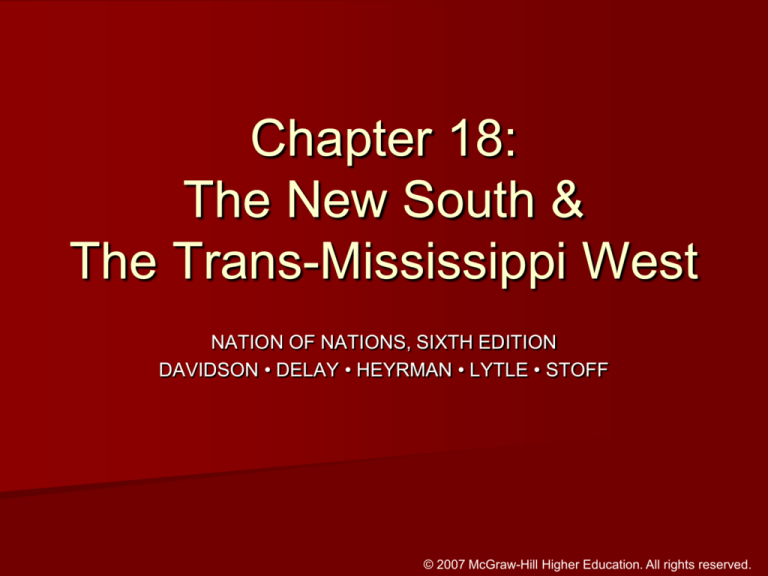
Chapter 18:
The New South &
The Trans-Mississippi West
NATION OF NATIONS, SIXTH EDITION
DAVIDSON • DELAY • HEYRMAN • LYTLE • STOFF
© 2007 McGraw-Hill Higher Education. All rights reserved.
2
Preview
“In the decades following Reconstruction, the
South and the West became more tightly linked
to the economy of the Northeast. Both regions
supplied the agricultural goods and raw
materials that fueled urban and industrial growth
in the northeastern and north central states.
Tragically, both were also racially divided
societies…”
© 2007 McGraw-Hill Higher Education. All rights reserved.
3
The Highlights
The Southern Burden
Life in the New South
Western Frontiers
War for the West
Boom and Bust in the West
The Final Frontier
© 2007 McGraw-Hill Higher Education. All rights reserved.
4
The Southern Burden
Agriculture in the New South
– A cotton-dominated economy
– Large families remained common in the South
Tenancy and Sharecropping
– Agricultural ladder: perception that any poor man
could work his way up rung by rung
– Crop lien system
© 2007 McGraw-Hill Higher Education. All rights reserved.
5
Tenant Farmers, 1900
© 2007 McGraw-Hill Higher Education. All rights reserved.
6
Southern Industry
– Boom in textiles
– Tobacco and cigarette growth encouraged
urbanization and investment
Timber and Steel
– Environmental costs
– Birmingham steel
© 2007 McGraw-Hill Higher Education. All rights reserved.
7
The Sources of Southern Poverty
– Late start in industrializing
– Undereducated labor
– The isolated southern labor market: fear of outsiders
“Under the campaign for a New South, all
[industries] grew dramatically in employment and
value, but not enough to end poverty or industrialize
the region.”
© 2007 McGraw-Hill Higher Education. All rights reserved.
Spending on Education in the South
before and after Disfranchisement
8
© 2007 McGraw-Hill Higher Education. All rights reserved.
9
Life in the New South
Rural Life
– Hunting: welcome relief from heavy farm work
– Farm entertainments: work-sharing festivals
celebrated the harvest
– Town: trips to town provided rural folks a chance to
mingle
© 2007 McGraw-Hill Higher Education. All rights reserved.
10
The Church
– Rural religion dominated the South
– Separation of race and gender
Segregation
– Laissez-faire race relations
– Jim Crow laws
– Plessy v. Ferguson
© 2007 McGraw-Hill Higher Education. All rights reserved.
11
Western Frontiers
Western Landscapes
– “Great American Desert”
– Complex web of cultures and environments
Indian Peoples and the Western Environment
– Variety of Indian cultures
– Shared reverence for nature
© 2007 McGraw-Hill Higher Education. All rights reserved.
12
Whites and the Western Environment:
Competing Visions
– William Gilpin, a western booster
– John Wesley Powell
– Water as a key resource
© 2007 McGraw-Hill Higher Education. All rights reserved.
13
Natural Environment of the West
© 2007 McGraw-Hill Higher Education. All rights reserved.
14
War for the West
Contact and Conflict
– Chivington massacre
– Buffalo soldiers
Custer’s Last Stand—and the Indians’
– Battle of Little Big Horn
– Chief Joseph
© 2007 McGraw-Hill Higher Education. All rights reserved.
15
Killing with Kindness
– La Fleche and Jackson
– The Dawes Act
– Wounded Knee
Borderlands
– Juan Jose Herrera and the White Caps
– Mexican immigrants worked mostly as contract and
seasonal laborers
– Formation of regional communities
© 2007 McGraw-Hill Higher Education. All rights reserved.
16
Ethno-Racial Identity in the New West
– A new racial triad: Anglos, African Americans, and
Latinos
– Racial identity in the New West would be more
complicated
“By the 1920s, a multiracial labor force of landless
wage earners worked on giant ranches and farms
across the Southwest. In Texas, the labor force was
triracial, but in California it also included Asian
Americans, and, elsewhere, American Indians.”
© 2007 McGraw-Hill Higher Education. All rights reserved.
17
Boom and Bust in the West
Mining Sets a Pattern
– Prostitution flourished openly in mining towns
– Environmental costs of mining
The Transcontinental Railroad
– Railroad land grants
– By threatening to bypass a town, railroad companies
could extract concessions
© 2007 McGraw-Hill Higher Education. All rights reserved.
18
Cattle Kingdom
– Home on the range—cattle ranches organized
according to family units and hired hands
– Western boom and bust
© 2007 McGraw-Hill Higher Education. All rights reserved.
19
The Final Frontier
A Rush for Land
– Boomers and Sooners
– Dream of the West as a garden paradise was being
shaken
Farming on the Plains
– Homestead Act
– Bonanza farms
© 2007 McGraw-Hill Higher Education. All rights reserved.
20
A Plains Existence
– Heaviest burdens fell to women
– Religion: Indians turned to traditional spiritualism and
Hispanics to the Catholic church
The Urban Frontier
– Transition from a raw frontier to a settled town
– Urban West growing at a rapid rate
© 2007 McGraw-Hill Higher Education. All rights reserved.
21
The West and the World Economy
– Foreign investment generally comes in two forms:
direct stock purchases and loans to western
corporations and individuals
– Westerners were part of a vast network of production
and trade that spanned the globe
© 2007 McGraw-Hill Higher Education. All rights reserved.






